Flexible Actuator Based on Conductive PAM Hydrogel Electrodes with Enhanced Water Retention Capacity and Conductivity
Abstract
1. Introduction
2. Materials and Methods
2.1. Materials
2.2. Methods
2.3. Preparation of Experimental Hydrogel Samples
2.4. Water Retention Capacity Testing Method
2.5. Conductivity Testing Method
2.6. System Reliability Tensile Testing Method
2.7. Fabrication of Flexible Actuator Based on PAM Conductive Hydrogel Electrodes
- (1)
- Mix component A and component B of Ecoflex 00-30 at 1:1, centrifuge it at an acceleration of 1500× g for 10 min, and drain the internal bubbles to prevent them affecting the production effect;
- (2)
- Pour the centrifuged mixture Ecoflex 00-30 material into a mold with a diameter of 60 mm for curing. The curing process lasts for 30 min in an oven at 60 °C. The dielectric elastomer layer with a diameter of 60 mm and a thickness of 1 mm will then be fabricated;
- (3)
- Pre-stretch the prepared Ecoflex dielectric elastomer film and fix it with a circular acrylic fixing frame with an inner diameter of 80 mm;
- (4)
- The surfaces of the dielectric elastomer will then be dried with nitrogen to enhance the adhesion of the hydrogels to the surfaces of the Ecoflex dielectric elastomer. Then, the pre-fabricated PAM conductive hydrogel electrodes will be closely bonded with the upper and lower sides of the pre-stretched dielectric elastomer film. The PAM conductive hydrogel electrodes on both sides will be used as the electrode lead out wire at an angle of 180° through the hydrogel thin wire, and they will be connected with the output end of the high-voltage power amplifier through the copper electrodes.
2.8. Actuation Experiment of Flexible Actuator
3. Results and Discussion
3.1. Water Retention Capacity Test
3.2. Conductivity Test
3.3. System Reliability Tensile Test
3.4. Actuation Experiment of Flexible Actuator Based on PAM Conductive Hydrogel Electrodes
4. Conclusions
Author Contributions
Funding
Data Availability Statement
Acknowledgments
Conflicts of Interest
References
- Hong, Y.; Lin, Z.; Yang, Y.; Jiang, T.; Shang, J.; Luo, Z. Biocompatible Conductive Hydrogels: Applications in the Field of Biomedicine. Int. J. Mol. Sci. 2022, 23, 4578. [Google Scholar] [CrossRef] [PubMed]
- Acome, E.; Mitchell, S.K.; Morrissey, T.G.; Emmett, M.B.; Benjamin, C.; King, M.; Radakovitz, M.; Keplinger, C. Hydraulically amplified self-healing electrostatic actuators with muscle-like performance. Science 2018, 359, 61–65. [Google Scholar] [CrossRef] [PubMed]
- Bariya, M.; Nyein, H.Y.Y.; Javey, A. Wearable sweat sensors. Nat. Electron. 2018, 1, 160–171. [Google Scholar] [CrossRef]
- Guo, Z.; Zhang, Z.; Zhang, N.; Gao, W.; Li, J.; Pu, Y.; He, B.; Xie, J. A Mg2+/polydopamine composite hydrogel for the acceleration of infected wound healing. Bioact. Mater. 2021, 15, 203–213. [Google Scholar] [CrossRef] [PubMed]
- Hong, Y.; Lin, Z.N.; Luo, Z.R.; Jiang, T.; Shang, J.Z.; Yang, Y. Development of conductive hydrogels: From design mechanisms to frontier applications. Bio-Des. Manuf. 2022, 5, 729–756. [Google Scholar] [CrossRef]
- Dastgeer, G.; Afzal, A.M.; Nazir, G.; Sarwar, N. p-GeSe/n-ReS2 Heterojunction Rectifier Exhibiting A Fast Photoresponse with Ultra-High Frequency-Switching Applications. Adv. Mater. Interfaces 2021, 8, 2100705. [Google Scholar] [CrossRef]
- Dastgeer, G.; Afzal, A.M.; Jaffery, S.H.A.; Imran, M.; Assiri, M.A.; Nisar, S. Gate modulation of the spin current in graphene/WSe2 van der Waals heterostructure at room temperature. J. Alloys Compd. 2022, 919, 165815. [Google Scholar] [CrossRef]
- Qi, J.; Su, G.; Li, Z. Gel-Based Luminescent Conductive Materials and Their Applications in Biosensors and Bioelectronics. Materials 2021, 14, 6759. [Google Scholar] [CrossRef]
- Zafar, M.S.; Dastgeer, G.; Kalam, A.; Al-Sehemi, A.G.; Imran, M.; Kim, Y.H.; Chae, H. Precise and Prompt Analyte Detection via Ordered Orientation of Receptor in WSe2-Based Field Effect Transistor. Nanomaterials 2022, 12, 1305. [Google Scholar] [CrossRef]
- Dastgeer, G.; Shahzad, Z.M.; Chae, H.; Kim, Y.H.; Ko, B.M.; Eom, J. Bipolar Junction Transistor Exhibiting Excellent Output Characteristics with a Prompt Response against the Selective Protein. Adv. Funct. Mater. 2022, 32, 4781. [Google Scholar] [CrossRef]
- Xiang, L.; Cui, W. Biomedical application of photo-crosslinked gelatin hydrogels. J. Leather Sci. Eng. 2021, 3, 3. [Google Scholar] [CrossRef]
- Tabatabai, A.; Fassler, A.; Usiak, C.; Majidi, C. Liquid-Phase Gallium–Indium Alloy Electronicswith Microcontact Printing. Langmuir 2013, 29, 6194–6200. [Google Scholar] [CrossRef]
- Scardaci, V.; Coull, R.; Coleman, J.N. Very thin transparent, conductive carbon nanotube films on flexible substrates. Appl. Phys. Lett. 2010, 97, 023114. [Google Scholar] [CrossRef]
- Lin, S.; Yuk, H.; Zhang, T.; Parada, G.A.; Koo, H.; Yu, C.; Zhao, X. Stretchable Hydrogel Electronics and Devices. Adv Mater 2016, 28, 4497–4505. [Google Scholar] [CrossRef] [PubMed]
- Echeverria, C.; Fernandes, S.N.; Godinho, M.H.; Borges, J.P.; Soares, P.I.P. Functional Stimuli-Responsive Gels: Hydrogels and Microgels. Gels 2018, 4, 54. [Google Scholar] [CrossRef] [PubMed]
- Li, W.; Lu, H.; Zhang, N.; Ma, M. Enhancing the Properties of Conductive Polymer Hydrogels by Freeze-Thaw Cycles for High-Performance Flexible Supercapacitors. ACS Appl. Mater. Interfaces 2017, 9, 20142–20149. [Google Scholar] [CrossRef] [PubMed]
- Ravarino, P.; Giuri, D.; Faccio, D.; Tomasini, C. Designing a Transparent and Fluorine Containing Hydrogel. Gels 2021, 7, 43. [Google Scholar] [CrossRef]
- Pu, X.; Liu, M.; Chen, X.; Sun, J.; Du, C.; Zhang, Y.; Zhai, J.; Hu, W.; Wang Zhong, L. Ultrastretchable, transparent triboelectric nanogenerator as electronic skin for biomechanical energy harvesting and tactile sensing. Sci. Adv. 2017, 3, e1700015. [Google Scholar] [CrossRef] [PubMed]
- Deng, Z.; Wang, H.; Ma, P.X.; Guo, B. Self-healing conductive hydrogels: Preparation, properties and applications. Nanoscale 2020, 12, 1224–1246. [Google Scholar] [CrossRef]
- Feig, V.R.; Tran, H.; Lee, M.; Bao, Z. Mechanically tunable conductive interpenetrating network hydrogels that mimic the elastic moduli of biological tissue. Nat. Commun. 2018, 9, 2740. [Google Scholar] [CrossRef]
- Keplinger, C.; Sun, J.Y.; Foo, C.C.; Rothemund, P.; Whitesides, G.M.; Suo, Z. Stretchable, Transparent, Ionic Conductors. Science 2013, 341, 984–987. [Google Scholar] [CrossRef] [PubMed]
- Jiang, G.; Wang, G.; Zhu, Y.; Cheng, W.; Cao, K.; Xu, G.; Zhao, D.; Yu, H. A Scalable Bacterial Cellulose Ionogel for Multisensory Electronic Skin. Research 2022, 2022, 9814767. [Google Scholar] [CrossRef] [PubMed]
- Robinson, S.S.; O’Brien, K.W.; Zhao, H.; Peele, B.N.; Larson, C.M.; Mac Murray, B.C.; Van Meerbeek, I.M.; Dunham, S.N.; Shepherd, R.F. Integrated soft sensors and elastomeric actuators for tactile machines with kinesthetic sense. Extrem. Mech. Lett. 2015, 5, 47–53. [Google Scholar] [CrossRef]
- Kubisa, P. Ionic liquids as solvents for polymerization processes—Progress and challenges. Prog. Polym. Sci. 2009, 34, 1333–1347. [Google Scholar] [CrossRef]
- Cheng, T.; Zhang, Y.Z.; Wang, S.; Chen, Y.L.; Gao, S.Y.; Wang, F.; Lai, W.Y.; Huang, W. Conductive Hydrogel-Based Electrodes and Electrolytes for Stretchable and Self-Healable Supercapacitors. Adv. Funct. Mater. 2021, 31, 2101303. [Google Scholar] [CrossRef]
- Zhou, Y.; Fei, X.; Tian, J.; Xu, L.; Li, Y. A ionic liquid enhanced conductive hydrogel for strain sensing applications. J. Colloid Interface Sci. 2022, 606, 192–203. [Google Scholar] [CrossRef]
- Weingärtner, H. An Introduction to Aqueous Electrolyte Solutions. By Margaret Robson Wright. ChemPhysChem 2008, 9, 1482. [Google Scholar] [CrossRef]
- Stokes, R.H.; Robinson, R.A. Ionic Hydration and Activity in Electrolyte Solutions. J. Am. Chem. Soc. 1948, 70, 1870–1878. [Google Scholar] [CrossRef]
- Zhou, Y.; Wan, C.; Yang, Y.; Yang, H.; Wang, S.; Dai, Z.; Ji, K.; Jiang, H.; Chen, X.; Long, Y. Highly Stretchable, Elastic, and Ionic Conductive Hydrogel for Artificial Soft Electronics. Adv. Funct. Mater. 2019, 29, 1806220. [Google Scholar] [CrossRef]
- Bai, Y.; Chen, B.; Xiang, F.; Zhou, J.; Wang, H.; Suo, Z. Transparent hydrogel with enhanced water retention capacity by introducing highly hydratable salt. Appl. Phys. Lett. 2014, 105, 151903. [Google Scholar] [CrossRef]
- Ristic, A.; Zabukovec Logar, N. New Composite Water Sorbents CaCl2;-PHTS for Low-Temperature Sorption Heat Storage: Determination of Structural Properties. Nanomaterials 2018, 9, 27. [Google Scholar] [CrossRef] [PubMed]
- Okada, K.; Nakanome, M.; Kameshima, Y.; Isobe, T.; Nakajima, A. Water vapor adsorption of CaCl2-impregnated activated carbon. Mater. Res. Bull. 2010, 45, 1549–1553. [Google Scholar] [CrossRef]
- Carvajal-Ortiz, R.A.; Svishchev, I.M. Properties of LiOH and LiCl at sub and supercritical water conditions. J. Mol. Liq. 2014, 190, 30–33. [Google Scholar] [CrossRef]
- Corsaro, C.; Mallamace, D.; Cicero, N.; Vasi, S.; Dugo, G.; Mallamace, F. Dynamics of water clusters in solution with LiCl. Phys. A-Stat. Mech. Its Appl. 2016, 442, 261–267. [Google Scholar] [CrossRef]
- Ji, D.; Park, J.M.; Oh, M.S.; Nguyen, T.L.; Shin, H.; Kim, J.S.; Kim, D.; Park, H.S.; Kim, J. Superstrong, superstiff, and conductive alginate hydrogels. Nat. Commun. 2022, 13, 3019. [Google Scholar] [CrossRef] [PubMed]
- Li, Q.; He, Y.; Tan, S.; Zhu, B.; Zhang, X.; Zhang, Z. Dielectric elastomer with excellent electromechanical performance by dipole manipulation of Poly(vinyl chloride) for artificial muscles under low driving voltage application. Chem. Eng. J. 2022, 441, 136000. [Google Scholar] [CrossRef]
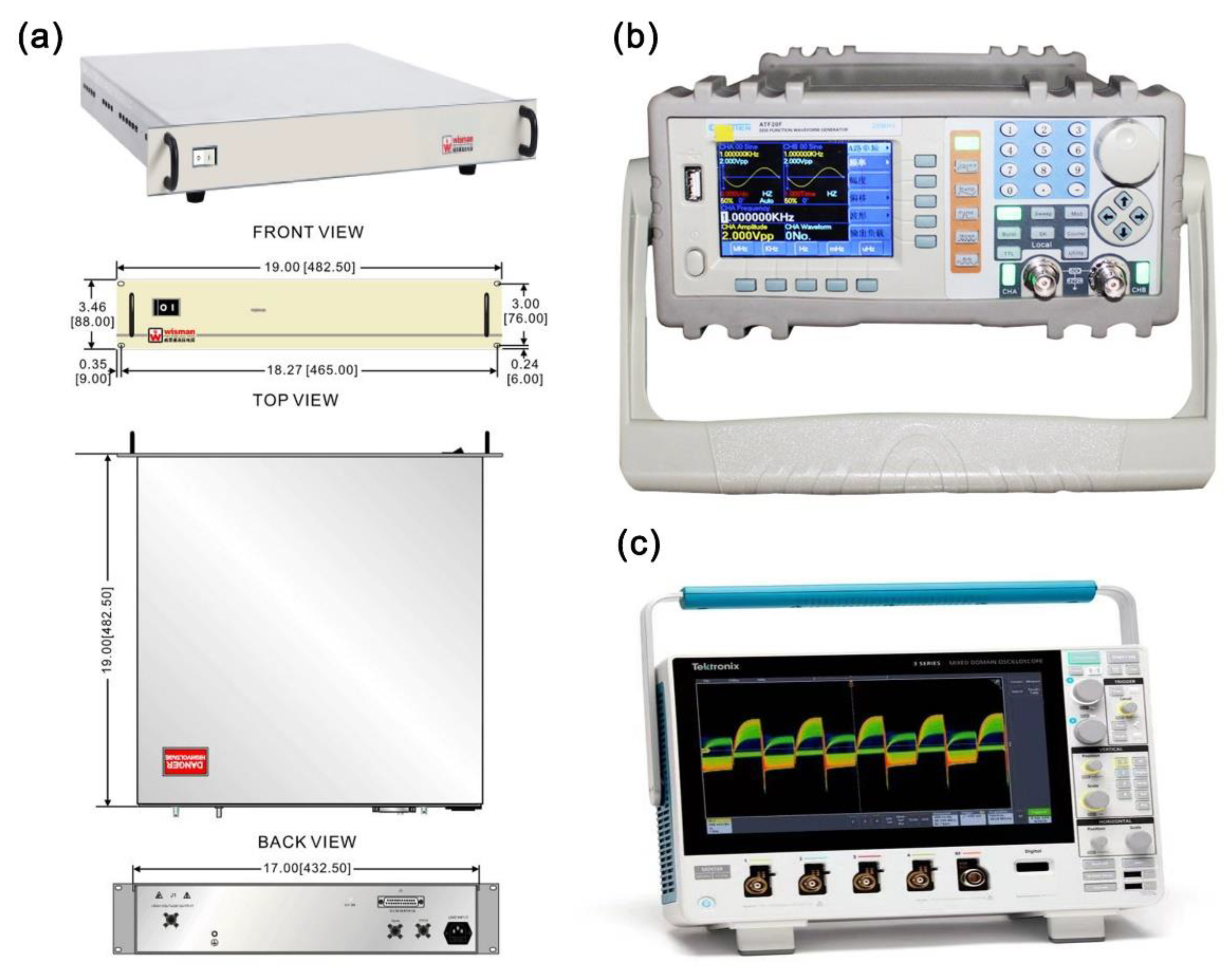
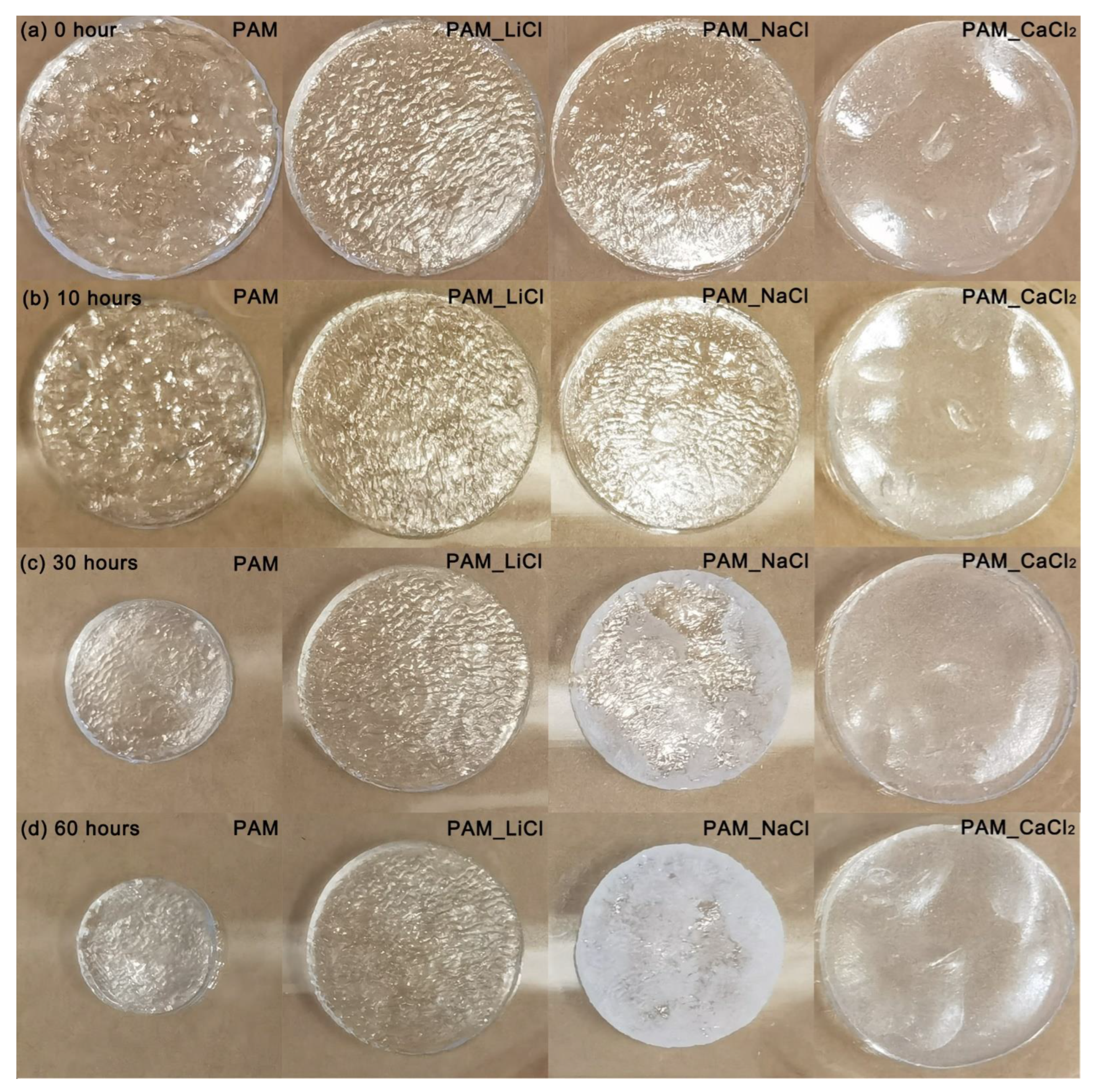

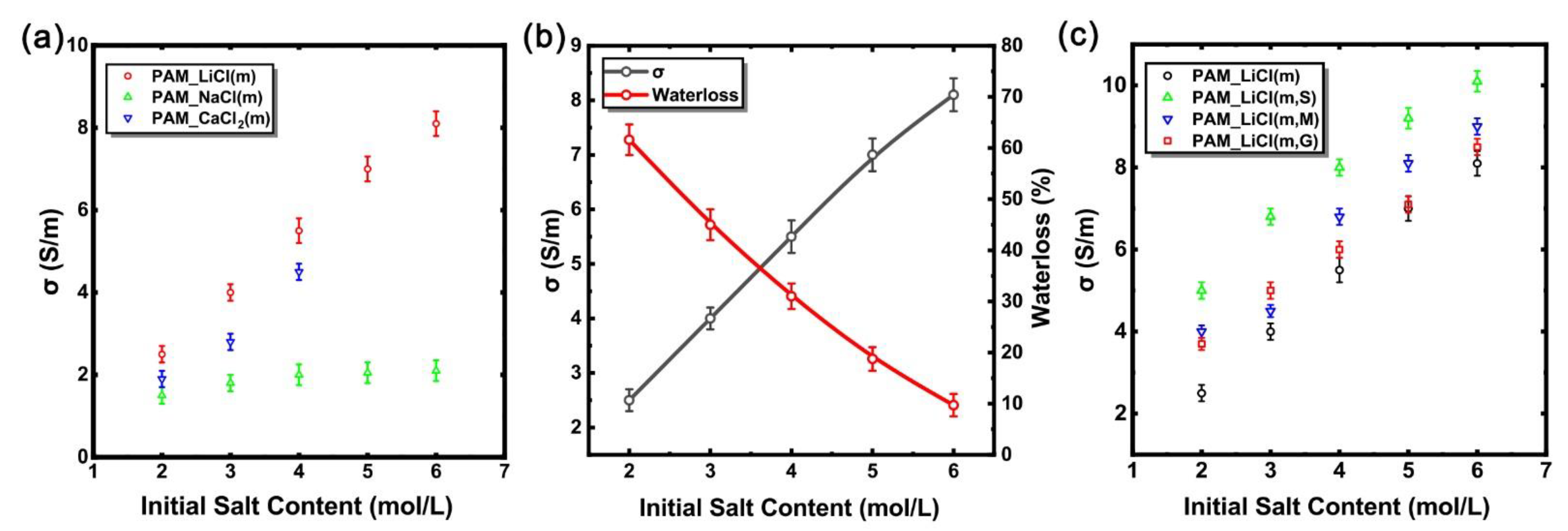


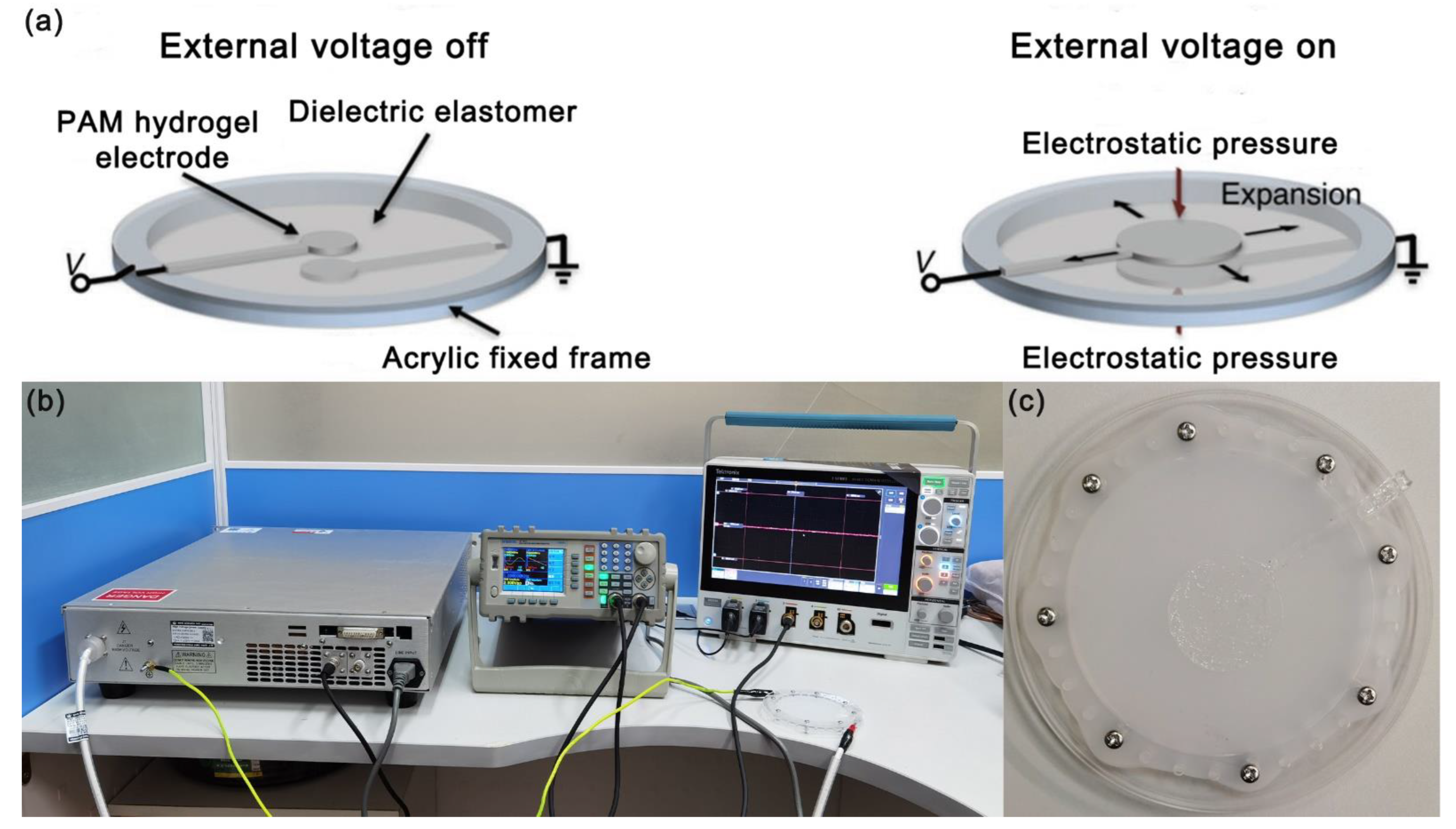
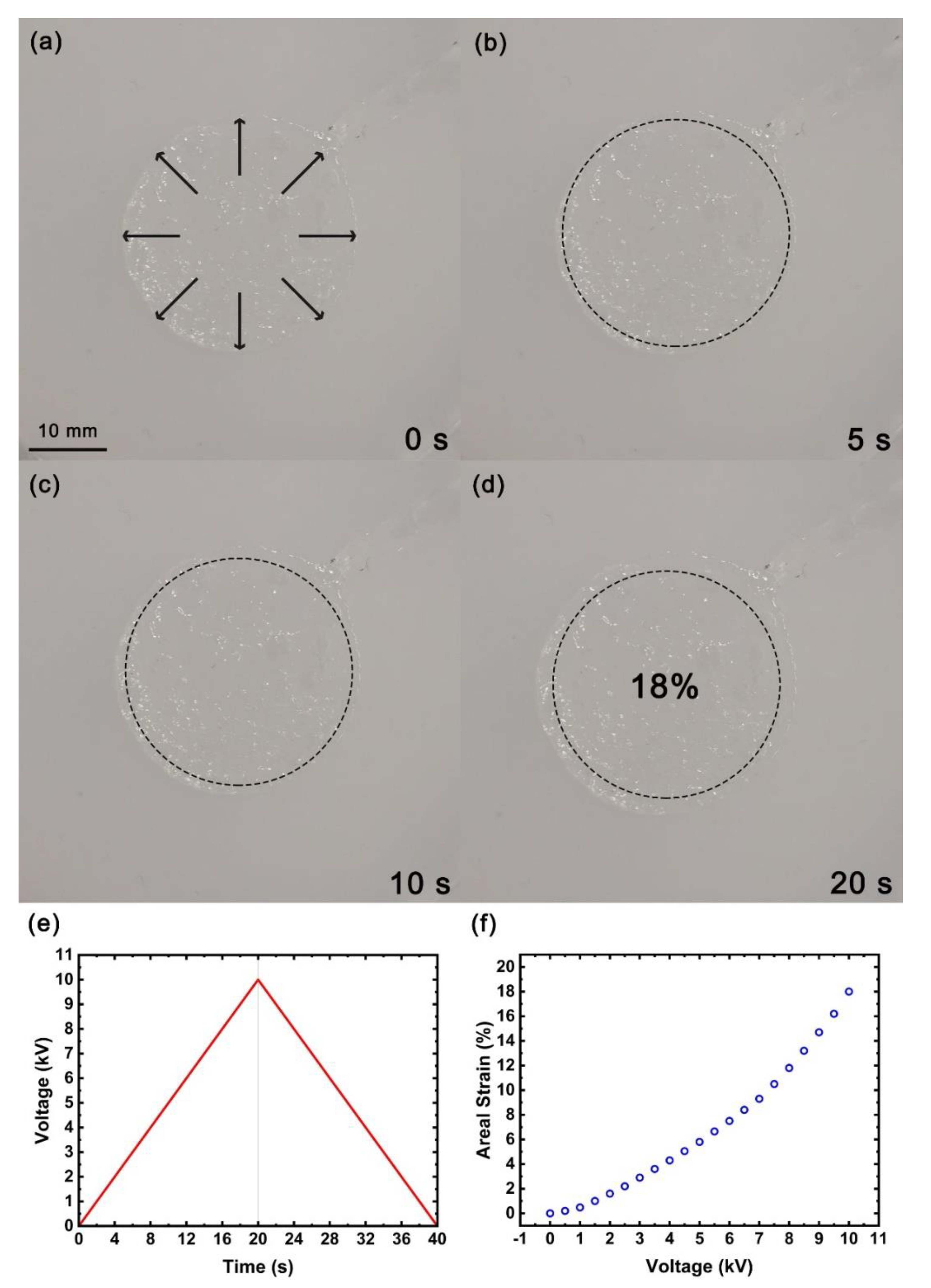
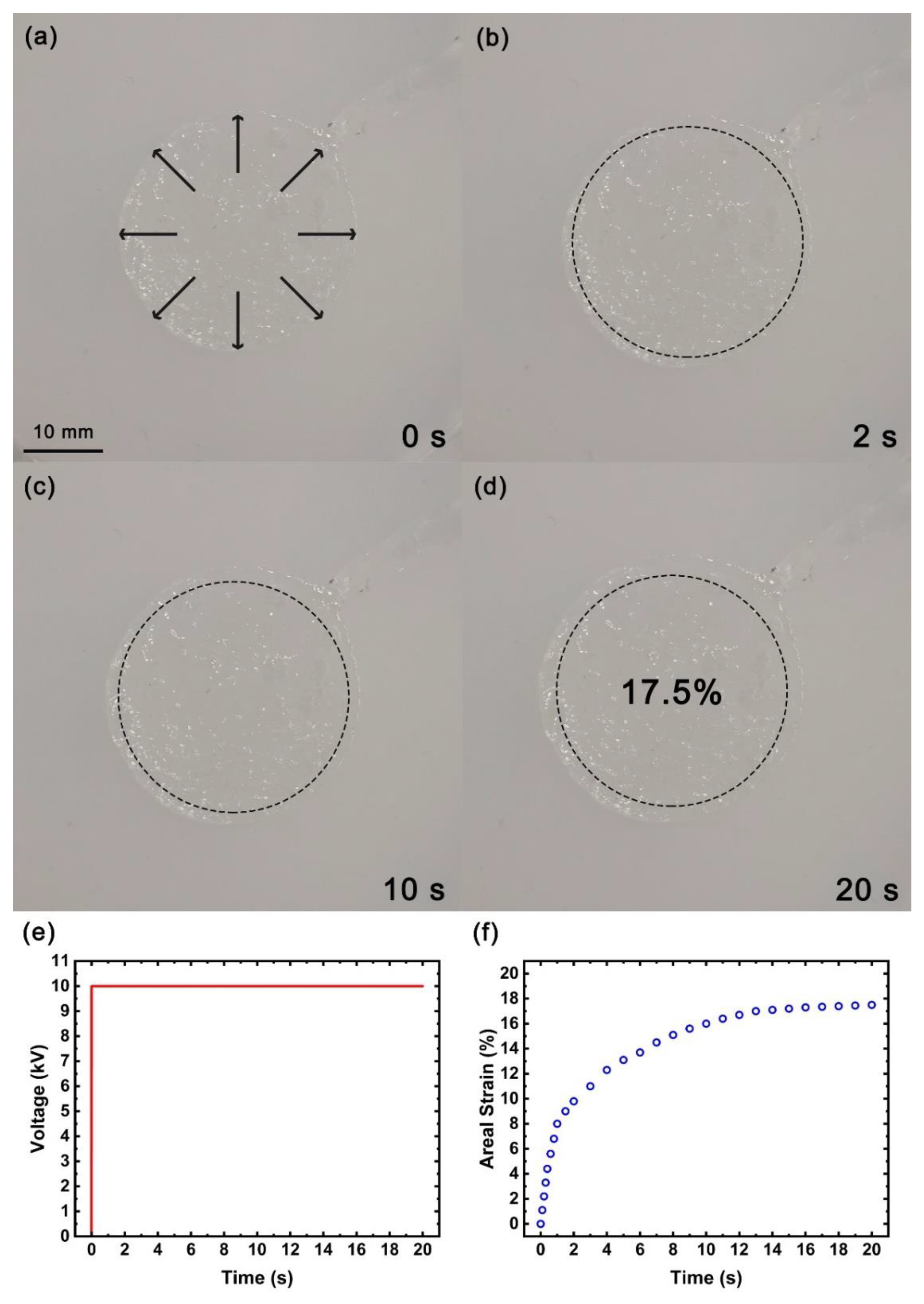
| Serial No | Name | Brand | Model | Number |
|---|---|---|---|---|
| 1 | Function signal generator | GRATTEN | ATF20F | 1 |
| 2 | High-voltage power amplifier | Wisman | AMR10R20 | 1 |
| 3 | Mixed domain digital oscilloscope | Tektronix | MDO34 | 1 |
Publisher’s Note: MDPI stays neutral with regard to jurisdictional claims in published maps and institutional affiliations. |
© 2022 by the authors. Licensee MDPI, Basel, Switzerland. This article is an open access article distributed under the terms and conditions of the Creative Commons Attribution (CC BY) license (https://creativecommons.org/licenses/by/4.0/).
Share and Cite
Hong, Y.; Lin, Z.; Yang, Y.; Jiang, T.; Shang, J.; Luo, Z. Flexible Actuator Based on Conductive PAM Hydrogel Electrodes with Enhanced Water Retention Capacity and Conductivity. Micromachines 2022, 13, 1951. https://doi.org/10.3390/mi13111951
Hong Y, Lin Z, Yang Y, Jiang T, Shang J, Luo Z. Flexible Actuator Based on Conductive PAM Hydrogel Electrodes with Enhanced Water Retention Capacity and Conductivity. Micromachines. 2022; 13(11):1951. https://doi.org/10.3390/mi13111951
Chicago/Turabian StyleHong, Yang, Zening Lin, Yun Yang, Tao Jiang, Jianzhong Shang, and Zirong Luo. 2022. "Flexible Actuator Based on Conductive PAM Hydrogel Electrodes with Enhanced Water Retention Capacity and Conductivity" Micromachines 13, no. 11: 1951. https://doi.org/10.3390/mi13111951
APA StyleHong, Y., Lin, Z., Yang, Y., Jiang, T., Shang, J., & Luo, Z. (2022). Flexible Actuator Based on Conductive PAM Hydrogel Electrodes with Enhanced Water Retention Capacity and Conductivity. Micromachines, 13(11), 1951. https://doi.org/10.3390/mi13111951









